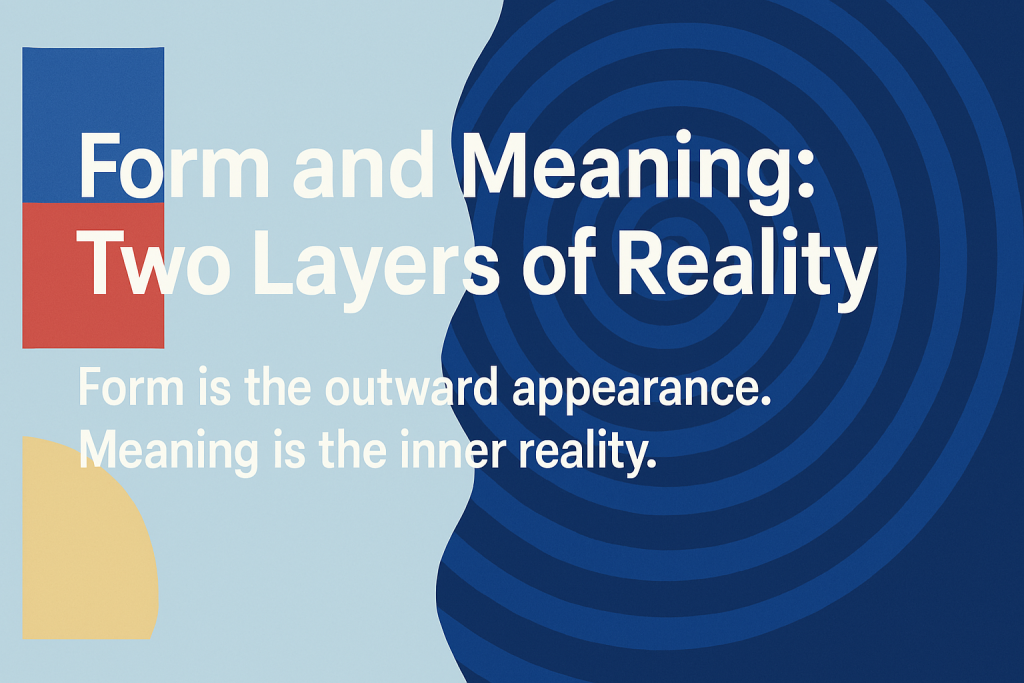Contents
- What is the meaning? And how does it differ from form?
What is the meaning? And how does it differ from form?
We live in a world of forms. Everything around us has contours, texture, structure—tables, windows, words, people’s behavior. Form seems obvious. But behind it, there is always a second layer—meaning, which may be elusive, but it is what truly determines what an object or action actually is.

Form is the outward appearance. Meaning is the inner reality.
Meaning is not found in the object. It is in the subject.
The same object—a chair, for example—can serve as a seat, a stand, a weapon, or even a symbol of authority. It all depends on the relationship the subject forms with it. A person can assign countless meanings to the same object—and none of these meanings are embedded in its form.
This is a fundamental distinction:
- Form is how an object looks and is physically perceived.
- Meaning is how the object is perceived in consciousness, the role it plays in the subject’s coordinate system.
Meaning is not fixed. It cannot be directly extracted from form. It arises in the interaction between subject and object. One person sees care in an action, another sees a threat. One sees wisdom in a text, another sees banality. But the text itself, the form, remains unchanged.
A problem arises when meaning is replaced by form
Today, judgments about a person or phenomenon are increasingly made by form. Behavior is evaluated superficially. Algorithms, people, systems—they react to patterns, appearances, models. They see the external and draw conclusions about the internal. They see the form and assign meaning. And they are often mistaken.
This is the very moment when form kills meaning. When something is condemned not for what it means, but for how it looks. When a label is attached to a person without understanding who they are. When an action is blocked without seeing what it was leading to.
Meaning is living context. It is always deeper.
Form is static. Meaning is fluid. The same act can be good or evil depending on the context. The same thought can be true or false depending on goal, motive, and circumstance.
You cannot understand a person only by appearance. Nor a thought—only by its form. Nor an action—by its outer shell. Everything requires penetrating to the essence. And this is only possible if you are ready to go beyond form and ask: what is the meaning here?
How and Where Form Kills Meaning: Real-Life Manifestations
So, the modern world is increasingly built on superficial perception. We live in a society where algorithms, templates, and standards play a decisive role. This leads to the substitution of deep content—meaning—by external features—form. Below are key spheres where this substitution is especially evident.
1. Psychology
A person comes to a psychologist with an internal conflict, with heavy experiences, seeking answers. But instead of dialogue, they are given a ready-made diagnosis: “You’re stuck in the past,” “This is emotional fixation,” “This is projection.” Instead of listening to the unique core of the experience, the specialist selects a template and begins to work with the form. This way, the most important thing is lost—the living, unique meaning that cannot be classified.
When inner depth is explained by a formula, meaning is blocked.
2. Law
The legal system is oriented toward procedure. It does not consider inner motivation, human context, or moral nuances. If all formal requirements are met—then everything is supposedly fine. Even if someone suffers or the truth has not been found. The law does not seek truth—it checks compliance with the norm.
Form can be observed even when justice is absent.
3. Social Interactions
When a person shares something personal or deep, often the response is: “You just want attention,” “You haven’t let go of the past,” “You’re overcomplicating.” People react to a recognizable form without delving into content. They do not ask: what is behind this?—because they see only the familiar wrapping. This leads to misunderstanding, isolation, loneliness.
Form creates the illusion of understanding. But without meaning, this understanding is false.
4. Science
Modern science demands that knowledge be experimentally confirmed, reproducible, subject to quantitative verification. But what about what does not fit existing paradigms? What about inner experience, qualitative states, structures of meaning that cannot be reduced to numbers? They are considered “outside of science.” But this does not mean they are false—only that science does not yet have the tools to measure them.
Science works with form. But meaning often exists before form—and outside of it.
5. Education and Upbringing
Schools and universities focus on external indicators: grades, credits, diplomas. But what about thinking? Depth? Understanding why all of this matters? Students are often not taught to think—they are taught to fulfill requirements. The result: a person “knows” formally, but does not understand. They can pass an exam but cannot recognize meaning outside the given form.
The form of learning does not guarantee mastery of meaning.
When Form Prevails, the Living Disappears
A person is not a formula, not a template, not a pattern. They are a bearer of meaning. And if you judge them only by the external—by words, actions, behavior, compliance—it is easy to make a mistake.
That is why the key question that culture, science, therapy, society, and education should ask themselves is not just what happened, but what is the meaning here?
Only then is restoration of wholeness possible. Only then will meaning become primary again.